More patients than ever before are showing an interest in having access to their medical records; one survey shows 92% of respondents indicating the importance of this. As a result, patient portal usage rates have steadily been increasing over time – 40% currently use them when available – though even those not yet using them have seen significant gains since 2017!
Patients who use portals tend to become more engaged with their treatment and experience shorter hospital stays and improved outcomes. Portals serve as an important way for patients to access their health information safely – payment information, scheduling appointments and communicating directly with providers are just some of the many uses they can find useful in accessing healthcare records through them.
Even though practices recognize the advantages of patient portals, many patients still aren’t taking full advantage of them, leading to missed opportunities for improved health outcomes. Therefore, medical practices need to create actionable steps designed to encourage patients to make use of access practice portals provide. Here Are Powerful Tips to Increase Patient Portal Usage.
Here are a few strategies your practice can implement to increase patient portal usage.
Encourage Patient Enrollment
People tend to resist changing their daily habits. Providers should explain the benefits available when patients use a portal and encourage enrollment by helping patients see its convenience and benefits for health and convenience. Providers should encourage enrollment while helping their patients grasp these advantages for themselves.
Advertise or Promote Your Portal
Advertising your portal can spread awareness among patients about its availability, as well as emphasize some of its advantages such as convenient scheduling and quick access to medical records and tests.
Establish a Patient Portal
Launching a patient portal is only the first step; to maximize its benefits for patients you should strive to continually enhance engagement and functionality of the portal provider as needed, and educate patients so that they get the most from it.
Make Sure Someone Is On Hand to Answer Any Queries
No matter how user-friendly your portal may be, patients will still have questions regarding its features or logging into it. Make sure your staff is available to provide answers for their inquiries.
Patient User Interface Should Be User-Friendly
New patients might initially find using a portal daunting; to ensure an intuitive and seamless user experience for them it’s key that everything is easily understandable, including directions and labels so patients can navigate screens efficiently to find what they are searching for without becoming frustrated.
Be Mobile Friendly
A large percentage of patients will access portals from mobile devices, so it is crucial that your portal be built to accommodate both computers and handheld devices.
Integrate Patient Portal Enrollment into Initial Care Procedures
By making enrollment part of their regular procedures, staff can encourage it and answer any queries as part of a normal care experience for patients. Offer Rewards To Encourage Participation.
Many practices find that offering rewards can help motivate patients to utilize the portal.
Understanding Low Portal Adoption Rates
With all of the wonderful advantages offered by patient portals, it may be puzzling why adoption rates remain so low. There may be multiple reasons, but most significantly is that many patients don’t know they exist – according to one study, 40% weren’t aware there was even an available portal or how to access it!
An important element in driving adoption is making sure providers, staff, and healthcare organizations actively encourage patients to use the portal. Make the process as effortless and convenient as possible for maximum impactful benefits.
Improving Care with CureMD Patient Portal
CureMD Patient Portal is a user-friendly and secure solution designed to engage and serve patients across any device, providing appointments, prescription refills, private messages from doctors and lab results in one convenient location. Patients can schedule or check appointment times, request refills of prescriptions they have already filled out as well as send/receive private messages from them at their fingertips – not forgetting HIPAA compliance for all data that passes through it.
